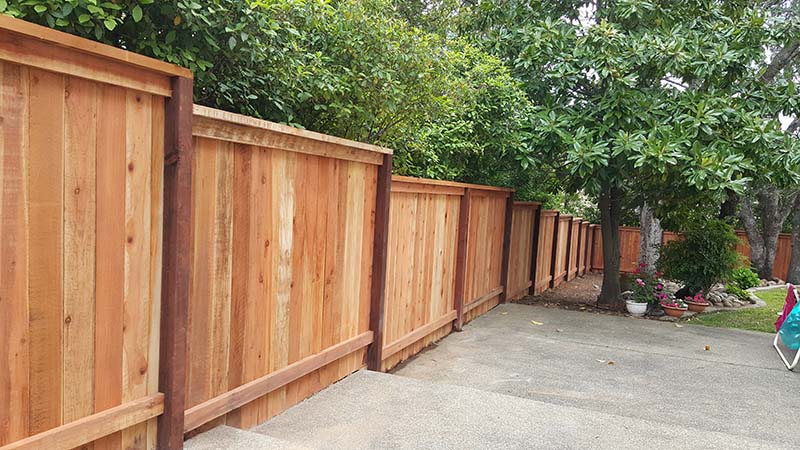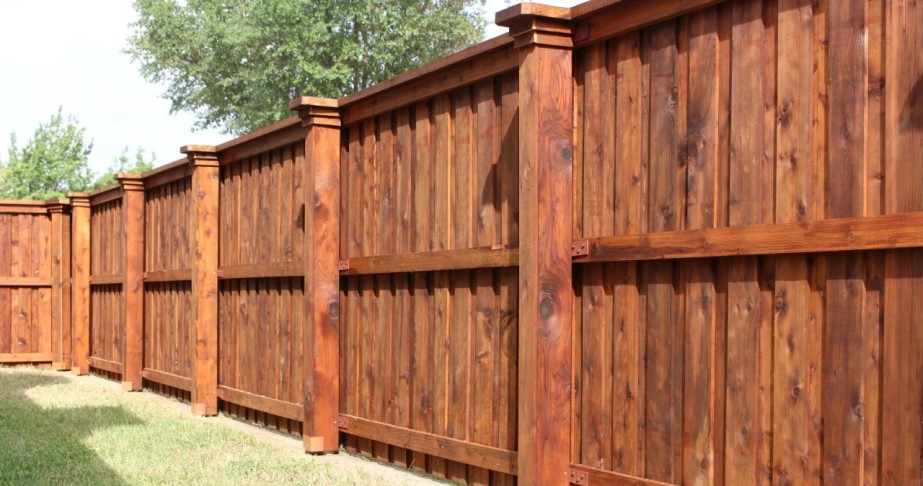Choosing the right fence style is crucial when it comes to securing and enhancing the privacy of your property.
After all, your fence is not only a physical barrier but also an extension of your home’s aesthetic and personal style.
That’s why it’s essential to explore all the options available before making a decision.
One popular option that strikes a balance between functionality and aesthetics is the board on board fence.
It’s a classic fencing style that offers a timeless appeal while providing the privacy and security you desire.
With its overlapping vertical boards, this fence style creates an elegant and cohesive look from all angles.
But there’s more to it than meets the eye.
Understanding the pros and cons of board on board fences will empower you to make an informed choice that suits your needs, budget, and personal taste.
What is Board on Board Fence?
Board on board fences are constructed by overlapping vertical boards on both sides of the fence, creating a visually pleasing appearance from all angles.
This design offers an extra layer of privacy compared to other fence styles.
Common materials used in board on board fences include wood, vinyl, composite, and metal.
You have the flexibility to customize the design and choose from various heights and board widths to suit your preferences and needs.
While the initial cost may be higher than some other fence styles, the long-term benefits often outweigh the investment.
Related: Shadow Box Fence Vs Board on Board Fence (Side by Side Comparison)
Pros of Board on Board Fences

Enhanced Privacy and Security
The overlapping boards in the fence provide excellent privacy, making it difficult for passersby to see inside your property.
This style also acts as a deterrent to trespassers and intruders, enhancing the overall security of your home.
Durability and Longevity
Board on board fences are constructed using sturdy materials and construction techniques that contribute to their strength.
This design, combined with the right choice of materials, makes the fence resistant to weather conditions, such as wind and rain, as well as pests like termites.
With proper maintenance, a board on board fence can last for many years.
Visual Appeal and Versatility
The elegant and classic look of the fence enhances the overall curb appeal of your property.
This style complements various architectural styles, adding a touch of sophistication and charm.
Whether your home has a traditional, modern, or rustic design, the fence can seamlessly blend in.
Noise Reduction
Board on board fences also offer noise reduction benefits.
The overlapping boards act as sound barriers, absorbing sound waves and reducing noise pollution.
The fence can help create a quieter environment if you live near a busy street or want a peaceful outdoor space.
Increased Property Value
Installing a board on board fence can potentially increase the value of your property.
The added privacy, security, and visual appeal are desirable features for potential buyers, making your home more marketable and potentially leading to a higher resale value.
Wind Resistance
The overlapping design of the fences provides enhanced wind resistance compared to other fence styles.
The gaps between the boards allow wind to pass through more freely, reducing the strain on the fence and minimizing the risk of damage during strong winds or storms.
Related: Shadow Box Fence Pros and Cons
Cons of Board on Board Fences

Increased Cost
Compared to other fence styles, board on board fences often come with a higher initial cost.
The additional materials and labor required for the overlapping design contribute to the increased expense.
However, considering the long-term benefits, the investment is worthwhile for many homeowners.
Maintenance Requirements
Board on board fences require regular maintenance to ensure their longevity.
This includes cleaning the fence periodically and sealing it to protect against moisture, UV rays, and potential warping or rotting.
While maintenance can be time-consuming, proper care will extend the lifespan of your fence.
Limited Airflow and Sunlight
Due to the overlapping boards, the fences limit airflow and sunlight penetration.
It’s important to consider this potential drawback if you prioritize a breezy and well-lit outdoor space.
However, creative solutions like spacing the boards or incorporating decorative cutouts can mitigate these concerns.
Reduced Natural Light
While the privacy offered by the fences is a desirable feature, it can also lead to a reduction in natural light within your property.
The overlapping boards restrict the amount of sunlight that enters your outdoor space, which may impact the brightness of your surroundings.
Consider this factor if you prioritize ample natural light in your outdoor areas.
Related: Advantages and Disadvantages of Dog Eared Fence
Choosing the Right Materials for Your Board on Board Fence
You have several options to consider when selecting materials for your fence.
Wood Options
Cedar, known for its natural resistance to decay and insects, is a popular choice for board on board fences.
Redwood offers similar benefits and boasts a beautiful reddish hue. Pressure-treated pine is another economical option, treated to resist rot and pests.
Alternative Materials
Vinyl fences are low-maintenance and durable, offering a range of colors and styles.
Composite materials, made from a combination of wood fibers and recycled plastic, provide the look of wood with increased durability and resistance to moisture.
Metal fences, such as aluminum or steel, offer a modern and sleek aesthetic, often with the advantage of low maintenance.
Board on Board Fence Installation and Maintenance Tips
If you decide to install a board on board fence, consider the following tips.

Steps involved in the installation
The installation process usually involves measuring and marking the layout, setting the posts securely in the ground, attaching horizontal rails, and then attaching the overlapping vertical boards.
Ensure accurate measurements, proper alignment, and use quality materials for a sturdy fence.
Hiring professionals vs. DIY
While a DIY approach can save money, hiring professionals ensures proper installation and potentially saves time and effort.
Professionals have the necessary expertise, tools, and experience to ensure your fence is built to last.
Maintenance best practices
Regular inspections are vital to identify any loose boards, damage, or signs of wear.
Cleaning your fence with mild soap and water, followed by sealing or staining, will help protect the wood or maintain the appearance of other materials.
Address any necessary repairs promptly to prevent further damage.
Comparing Board on Board Fences with Other Fence Styles
To understand how board on board fences stack up against other fence styles, let’s explore some popular alternatives.
Privacy Fences
Board on board fences excel in providing privacy, surpassing many other fence styles in this aspect. They offer better coverage and aesthetic appeal compared to solid panel fences.
Picket Fences
These are known for their charm and open design. While they provide a level of visual appeal, they fall short in terms of privacy and security when compared to board on board fences.
Chain-Link Fences
They’re affordable and functional but lack the privacy and aesthetic appeal of board on board fences.
They may be suitable for specific applications, such as enclosing a backyard or securing a commercial property.
Stockade Fences
Stockade fences offer privacy similar to board on board fences but lack the visual appeal and versatility.
They consist of solid panels without the overlapping design, limiting customization options.
Related
- Shadow Box Fence Pros and Cons
- Top 5 Freeman Framing Nailers Review
- Shadow Box Fence Vs Board on Board Fence (Side by Side Comparison)
- How to Clean Algae off Landscape Rocks (Step-by-Step)
- Top 5 Types of Pillowcase Closures
- Unknown Advantages of Foam Paint Rollers


